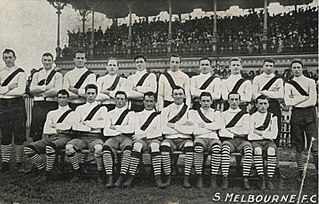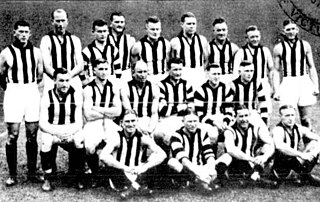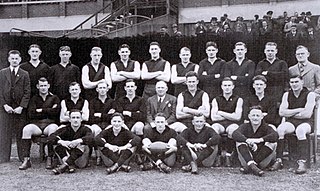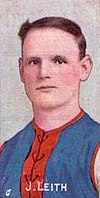
The 1897 VFL season was the inaugural season of the Victorian Football League (VFL), the highest-level senior Australian rules football competition in Victoria. The season ran from 8 May to 4 September, comprising a 14-round home-and-away season followed by a three-week finals series featuring the top four clubs. Eight Victorian Football Association (VFA) clubs – Carlton, Collingwood, Essendon, Fitzroy, Geelong, Melbourne, South Melbourne and St Kilda – featured in the inaugural season after seceding from the VFA in 1896.

The 1899 VFL season was the third season of the Victorian Football League (VFL), the highest-level senior Australian rules football competition in Victoria. The season featured eight clubs and ran from 13 May to 16 September, comprising a 14-round home-and-away season followed by a finals series featuring all eight clubs.

The 1901 VFL season was the fifth season of the Victorian Football League (VFL), the highest-level senior Australian rules football competition in Victoria. The season featured eight clubs and ran from 4 May to 7 September, comprising a 17-round home-and-away season followed by a two-week finals series featuring the top four clubs.

The 1902 VFL season was the sixth season of the Victorian Football League (VFL), the highest-level senior Australian rules football competition in Victoria. The season featured eight clubs and ran from 3 May to 20 September, comprising a 17-round home-and-away season followed by a three-week finals series featuring the top four clubs.

The 1907 VFL season was the eleventh season of the Victorian Football League (VFL), the highest-level senior Australian rules football competition in Victoria. The season featured eight clubs and ran from 27 April to 21 September, comprising a 17-match home-and-away season followed by a three-week finals series featuring the top four clubs.
The 1953 VFL season was the 57th season of the Victorian Football League (VFL), the highest level senior Australian rules football competition in Victoria. The season featured twelve clubs, ran from 18 April until 26 September, and comprised an 18-game home-and-away season followed by a finals series featuring the top four clubs.

The 1909 VFL season was the 13th season of the Victorian Football League (VFL), the highest-level senior Australian rules football competition in Victoria. The season featured ten clubs and ran from 1 May to 2 October, comprising an 18-match home-and-away season followed by a four-week finals series featuring the top four clubs.
The 1989 VFL season was the 93rd season of the Victorian Football League (VFL), the highest level senior Australian rules football competition and administrative body in Victoria and, by reason of it featuring clubs from New South Wales, Queensland and Western Australia, the de facto highest level senior competition in Australia. It was the last season under the Victorian Football League name, before being renamed the Australian Football League in 1990. The season featured fourteen clubs, ran from 31 March until 30 September, and comprised a 22-game home-and-away season followed by a finals series featuring the top five clubs.

The 1924 VFL season was the 28th season of the Victorian Football League (VFL), the highest-level senior Australian rules football competition in Victoria. The season featured nine clubs and ran from 26 April to 27 September, comprising a 16-match home-and-away season followed by a three-week finals series featuring the top four clubs.

The 1926 VFL season was the 30th season of the Victorian Football League (VFL), the highest-level senior Australian rules football competition in Victoria. The season featured twelve clubs and ran from 1 May to 9 October, comprising an 18-match home-and-away season followed by a four-week finals series featuring the top four clubs.
The 1928 VFL season was the 32nd season of the Victorian Football League (VFL), the highest-level senior Australian rules football competition in Victoria. The season featured twelve clubs and ran from 21 April to 29 September, comprising an 18-match home-and-away season followed by a four-week finals series featuring the top four clubs.
The 1929 VFL season was the 33rd season of the Victorian Football League (VFL), the highest-level senior Australian rules football competition in Victoria. The season featured twelve clubs and ran from 27 April to 28 September, comprising an 18-match home-and-away season followed by a four-week finals series featuring the top four clubs.

The 1930 VFL season was the 34th season of the Victorian Football League (VFL), the highest-level senior Australian rules football competition in Victoria. The season featured twelve clubs and ran from 3 May to 11 October, comprising an 18-match home-and-away season followed by a four-week finals series featuring the top four clubs.
The 1931 VFL season was the 35th season of the Victorian Football League (VFL), the highest-level senior Australian rules football competition in Victoria. The season featured twelve clubs and ran from 2 May to 10 October, comprising an 18-match home-and-away season followed by a four-week finals series featuring the top four clubs.

The 1934 VFL season was the 38th season of the Victorian Football League (VFL), the highest-level senior Australian rules football competition in Victoria. The season featured twelve clubs and ran from 5 May to 13 October, comprising an 18-match home-and-away season followed by a four-week finals series featuring the top four clubs.

The 1937 VFL season was the 41st season of the Victorian Football League (VFL), the highest level senior Australian rules football competition in Victoria. The season featured twelve clubs, ran from 24 April until 25 September, and comprised an 18-game home-and-away season followed by a finals series featuring the top four clubs.

The 1939 VFL season was the 43rd season of the Victorian Football League (VFL), the highest level senior Australian rules football competition in Victoria. The season featured twelve clubs, ran from 22 April until 30 September, and comprised an 18-game home-and-away season followed by a finals series featuring the top four clubs.
The 1941 VFL season was the 45th season of the Victorian Football League (VFL), the highest level senior Australian rules football competition in Victoria. The season featured twelve clubs, ran from 26 April until 27 September, and comprised an 18-game home-and-away season followed by a finals series featuring the top four clubs.

The 1942 VFL season was the 46th season of the Victorian Football League (VFL), the highest level senior Australian rules football competition in Victoria.
The 1897 VFL season was the Geelong Football Club's first season in the Victorian Football League and its first with Jack Conway as captain. Geelong finished the home and away season with 11 wins and 3 losses, finishing in first position and winning the minor premiership. In the final series, Geelong finished with 2 wins and 1 loss, finishing in second position.























